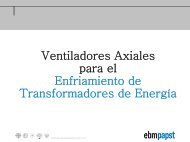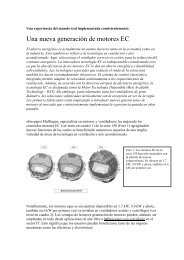Download [PDF] 2.3 MB - ebm-papst UK
Download [PDF] 2.3 MB - ebm-papst UK
Download [PDF] 2.3 MB - ebm-papst UK
Create successful ePaper yourself
Turn your PDF publications into a flip-book with our unique Google optimized e-Paper software.
DIFFUSER AXITOPEnergy consumptionin kW2.521.51Outputin m 3 /h25,00024,00023,00022,00021,00020,00019,00018,000-27 %+9 %Noise development (LwA)in dB(A)90858075709085807570-7.2 dB(A)Noise development (LwA)in dB(A)-4.9 dB(A)Figure 4a (left, up): Energyconsumption and noise developmentare significantly lower withunchanged air performance.Figure 4b (left, down): Bloweroutput is increased and noisereduced with unchanged powerinput. Details from an exampleapplication.Figure 5 (right): The thrust range isnot affected by the AxiTop diffuser.The illustration shows the axial flowrate with diffuser on the left andwithout diffuser on the right.not only does the user save energy during operation;the design engineer for a climate controlsystem can get by with smaller heat exchangersurface areas. The space needed for the coolingunit can be reduced with unchanged or even improvednoise behavior and constant refrigerationcapacity. The reduction in the space needed isan argument which cannot be neglected, aboveall for larger heat exchangers. A diffuser is evenworthwhile if it subsequently turns out that thesystem does not have a sufficient refrigerationcapacity, e.g. in the case of a design error. It enhancesthe air performance without increasingnoise. In such cases, the installation of an additionalheat exchanger (and the associated costs)can often be avoided.Can be retrofitted and used in existing wallrings Equipping existing heat exchangers with adiffuser is easy and only requires a few changesto ventilation and air-conditioning units. The diffuseris fitted in place of the guard grille. Existingwall rings can still be used. The AxiTop diffuserfrom <strong>ebm</strong>-<strong>papst</strong> is just 250 mm high so it needsvery little space.With these dimensions, the developmentengineers have succeeded in achieving a verygood compromise. Physically, a diffuser cannotbe large enough in order to increase staticpressure. But dimensions which are as compactas possible are required in practice. CFD simulationscombined with parametric optimisationshave produced an excellent aerodynamic result.The change in the outflow profile causes the flowto split slightly, enabling the thrust range of thefan to be maintained. Figure 5 shows the differentcharacteristics of the exit speed cax, which is ofrelevance for the thrust range, with and withouta diffuser.The new AxiTop diffuser is designed for fansof the sizes 800 and 910. Versions for 500 whichare frequently employed with heat exchangerswill follow in the near future. It doesn´t matterwhether the fan works with GreenTech EC or withan AC drive. However, in the interest of energy efficiency,the combination with GreenTech EC fansin certainly preferable.Authors are Dipl.-Ing. (FH) Oliver Haaf, head of Product Development, Aerodynamicsgroup (left) and Dipl.-Ing (FH) Markus Engert, Predevelopment,Aerodynamics (right) at <strong>ebm</strong>-<strong>papst</strong> MulfingenYou would like more information on this topic? Please address your questionto: Oliver.Haaf@de.<strong>ebm</strong><strong>papst</strong>.com or Markus.Engert@de.<strong>ebm</strong><strong>papst</strong>.comtechmag 01°201311


![Download [PDF] 2.3 MB - ebm-papst UK](https://img.yumpu.com/52907850/11/500x640/download-pdf-23-mb-ebm-papst-uk.jpg)



![[PDF] 22.3 MB - ebm-papst Argentina](https://img.yumpu.com/7645467/1/184x260/pdf-223-mb-ebm-papst-argentina.jpg?quality=85)